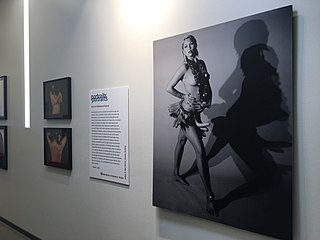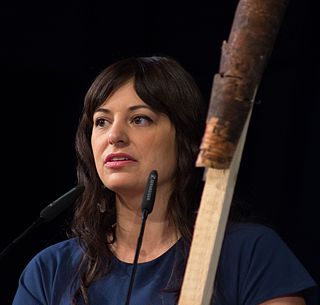The topic of this article may not meet Wikipedia's general notability guideline .(October 2024) |
Merritt Johnson (born 1977) [1] [2] is an American contemporary artist, often centering her work on Native American themes. [3]
The topic of this article may not meet Wikipedia's general notability guideline .(October 2024) |
Merritt Johnson (born 1977) [1] [2] is an American contemporary artist, often centering her work on Native American themes. [3]
Johnson was born in Baltimore, Maryland, in 1977. [1] [2] [4]
Her love for art began when she was very young when she discovered a book with Picasso's paintings. [5]
She received a Bachelor's in Fine Arts from Carnegie Mellon University and a Master's in Fine Arts from the Massachusetts College of Art and Design. [4]
Johnson said that her art is viewed differently by Indigenous and non-Indigenous viewers because of their lack of knowledge and understanding of Indigenous terms, culture, and land. [5] She wrote that when people hear about Native American Art, most of them think of "beads and feathers". [3] [6] She uses traditional materials to create emphasis on problems that have had a long history. [6]
She described herself and was described by others in 2014–2018 as being of Mohawk and Blackfoot descent or "mixed Kanienkehaka (Mohawk), Blackfoot, and non-Indigenous descent". [3] [6] [7] [8] [9] [10] However, in May 2021 after her claims of Indigenous ancestry were challenged, Johnson withdrew her work from a Fruitlands Museum exhibition of works by Native American artists. [11]
Johnson's personal website has varied over time in her description of herself including "the daughter of Kanienkehaka (Mohawk), Blackfoot, and North American settlers" in 2014, [12] as "a woman of mixed Onkwehonwe* and settler descent" in 2016, [13] as "not claimed by, nor a citizen of any nation from which she descends (Irish, Kanien’keha:ká/Mohawk, Blackfoot, Jamaican, Swedish) in 2021 [14] and as "not claimed by, nor a citizen of any nation from which she descends" (without names). [15]
Johnson's work has been held in the following permanent collections:
This section of a biography of a living person needs additional citations for verification .(March 2020) |
Johnson is married and is the mother and stepmother of six children. She lives with her family in Sitka, Alaska. [17]

The Institute of American Indian Arts (IAIA) is a public tribal land-grant college in Santa Fe, New Mexico, United States. The college focuses on Native American art. It operates the Museum of Contemporary Native Arts (MoCNA), which is housed in the historic Santa Fe Federal Building, a landmark Pueblo Revival building listed on the National Register of Historic Places as Federal Building. The museum houses the National Collection of Contemporary Indian Art, with more than 7,000 items.
Jaune Quick-to-See Smith is a Native American visual artist and curator. She is an enrolled member of the Confederated Salish and Kootenai Tribes and is also of Métis and Shoshone descent. She is an educator, storyteller, art advocate, and political activist. Over the course of her five-decade long career, Smith has gained a reputation for her prolific work, being featured in over 90 solo exhibitions, curating over 30 exhibitions, and lecturing at approximately 200 museums, universities, and conferences. Her work draws from a Native worldview and comments on American Indian identity, histories of oppression, and environmental issues.

Melanie A. Yazzie is a Navajo sculptor, painter, printmaker, and professor. She teaches at the University of Colorado at Boulder.

Linda Lomahaftewa is a Native American printmaker, painter, and educator living in Santa Fe, New Mexico. She is a citizen of the Hopi Tribe and a descendant of the Choctaw Nation of Oklahoma.
Teri Greeves is a Native American beadwork artist, living in Santa Fe, New Mexico. She is enrolled in the Kiowa Indian Tribe of Oklahoma.
Shelley Niro is a Mohawks of the Bay of Quinte filmmaker and visual artist from New York and Ontario. She is known for her photographs using herself and female family members cast in contemporary positions to challenge the stereotypes and clichés of Native American women.

Erica Lord is an Alaska Native artist, based in Santa Fe, New Mexico, who identifies herself as a mixed-race "cultural limbo."
Babe and Carla Hemlock are a Kahnawake Mohawk husband-and-wife artisan team from Kahnawake Mohawk Nation Territory near Montreal. Babe specializes in woodcarving, and Carla focuses on textile arts; however, they work in a range of different artistic media. Carla has been recognized for her award-winning quilt work, which has been purchased by the National Museum of the American Indian, part of the Smithsonian Institution in Washington, D.C.
Dyani White Hawk is a contemporary artist and curator of Sicangu Lakota, German, and Welsh ancestry based out of Minnesota. From 2010 to 2015, White Hawk was a curator for the Minneapolis gallery All My Relations. As an artist, White Hawk's work aesthetic is characterized by a combination of modern abstract painting and traditional Lakota art. White Hawk's pieces reflect both her Western, American upbringing and her indigenous ancestors mediums and modes for creating visual art.
Skawennati is a First Nations (Kahnawakeronon) multimedia artist, best known for her online works as well as Machinima that explore contemporary Indigenous cultures, and what Indigenous life might look like in futures inspired by science fiction. She served as the 2019 Indigenous Knowledge Holder at McGill University. In 2011, she was awarded an Eiteljorg Contemporary Art Fellowship which recognized her as one of "the best and most relevant native artists."
Tammy Beauvais is a First Nations fashion designer from Kahnawake Mohawk Territory in Quebec, Canada. She left Kahnawake in 1990 following the Oka Crisis. In 1999 Beauvais launched Tammy Beauvais Designs a North American Indigenous Fashion company which produces contemporary, authentically Indigenous made clothing that honors Indigenous spirituality and traditions.

Candice Hopkins is a Carcross/Tagish First Nation independent curator, writer, and researcher who predominantly explores areas of art by Indigenous peoples. She is the executive director and chief curator at the Forge Project in New York.
Cara Romero is an American photographer known for her digital photography that examines Indigenous life through a contemporary lens. She lives in both Santa Fe, New Mexico and the Mojave Desert. She is an enrolled citizen of the Chemehuevi Indian Tribe.
Zoë Marieh Urness is a photographer of Alaskan Tlingit and Cherokee Native American heritage. She creates portraits of modern Indigenous cultures in traditional regalia and settings.

Rose B. Simpson is a Tewa sculptor of Khaʼpʼoe Ówîngeh is a mixed-media artist who works in ceramic, metal, fashion, painting, music, performance, and installation. She lives and works in Santa Clara Pueblo, New Mexico. Her work has been exhibited at SITE Santa Fe ; the Heard Museum ; the Museum of Contemporary Native Art, Santa Fe (2010); the National Museum of the American Indian, Smithsonian (2008); the Denver Art Museum; Pomona College Museum of Art (2016); Ford Foundation Gallery (2019); The Wheelwright Museum of the American Indian (2017); the Minneapolis Institute of Art (2019); the Savannah College of Art and Design (2020); the Nevada Museum of Art (2021); Whitney Museum of American Art, and the Norton Museum of Art (2024).
Nanibah "Nani" Chacon is a Diné and Chicana painter, muralist, and art educator. Her work has been installed at the IAIA Museum of Contemporary Native Arts in Santa Fe, the Navajo Nation Museum in Window Rock, the ISEA International Arts and Technology Symposium, Old Town Lansing, and in the "Que Chola" Exhibition at the National Hispanic Cultural Center in Albuquerque, among other venues.
Melissa Cody is a Navajo textile artist from No Water Mesa, Arizona, United States. Her Germantown Revival style weavings are known for their bold colors and intricate three dimensional patterns. Cody maintains aspects of traditional Navajo tapestries, but also adds her own elements into her work. These elements range from personal tributes to pop culture references.
Margaret E. Jacobs is a Native American artist and member of the Akwesasne Mohawk tribe, known for her steel sculptures, powdercoated jewelry, and drawings. She draws inspiration from her culture and upbringing. She values natural and synthetic objects and is inspired by buildings in the United States; they are a reminder of Mohawk ironworkers who left their tribes and communities to help build structures. Most of Jacobs' work has been based on the history of the Mohawks, her cultural heritage, and stories.
Melissa Melero-Moose is a Northern Paiute/Modoc mixed-media artist and co-founder of Great Basin Native Artists, a collective based in Nevada. She is enrolled in the Paiute-Shoshone Tribe of the Fallon Reservation and Colony.
Ursala Hudson is an Alaska Native textile artist, graphic designer, and fashion designer. She also photographs and paints. She creates Chilkat weaving, including dance regalia, belts, collars, and earrings.